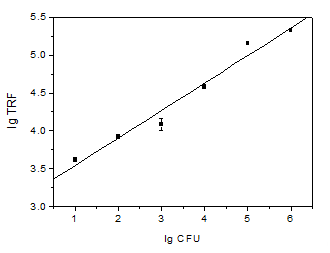| [1] Meng, S.; Wang, Y.; Wang, Y.; Liu, D.; Ye, C. Lett. Appl. Microbiol. 2015, 61(2), 171.
[2] Chalifoux, L. V.; Hajema, E. M.; Leeparritz, D. Lab. Anim. Sci. 1993, 43(4), 355.
[3] Fu, X. Z.; Lin, Q.; Liu, L. H.; Liang, H. R.; Huang, Z. B.; Li, N. Q. Fish Shellfish Immun. 2016, 56, 286.
[4] Griffin, M. J.; Goodwin, A. E.; Merry, G. E.; Liles, M. R.; Wil-liams, M. A.; Ware, C.; Waldbieser, G. C. J. Vet. Diagn. Invest. 2013, 25(4), 473.
[5] Guo, S.-L.; Guan, R.-Z. Journal of Huazhong Agriculture University 2009, 28(4), 463(in Chinese). (郭松林, 关瑞章, 华中农业大学学报, 2009, 28(4), 463.)
[6] Chauret, C.; Volk, C.; Creason, R.; Jarosh, J.; Robinson, J.; Warnes, C. Can. J. Microbiol. 2001, 47(8), 782.
[7] Hussain, I. A.; Jeyasekaran, G.; Shakila, R. J.; Raj, K. T.; Jeevithan, E. J. Food Sci. Tech. Mys. 2014, 51(2), 401.
[8] Chen, C.-F. J. Huazhong Agriculture University 1998, 17(3), 264(in Chinese). (陈昌福, 华中农业大学学报, 1998, 17(3), 264.)
[9] Hu, D.-Y.; Qian, D.; Liu, W.; Zhang, Y.-P.; Pan, Q.-Q.; Chen, C.-F. Journal of Huazhong Agriculture University 2008, 27(1), 80(in Chinese). (胡大雁, 钱冬, 刘问, 张友平, 潘清清, 陈昌福, 华中农业大学学报, 2008, 27(1), 80.)
[10] Jiang, H. F.; Wang, G. L.; Zhang, W. Z.; Liu, X. Y.; Ye, Z. Q.; Jin, D. Y.; Yuan, J. L.; Liu, Z. G. J. Fluoresc. 2010, 20(1), 321.
[11] Kupstat, A.; Kumke, M. U.; Hildebrandt, N. Analyst 2011, 136(5), 1029.
[12] Lu, J.; Guo, S.-L.; Feng, J.-J.; Wang, Y.-L.; Zhu, H.-Q.; Lin, P. Chinese J. Anal. Chem. 2012, 40(11), 1709(in Chinese). (卢洁, 郭松林, 冯建军, 王艺磊, 朱洪泉, 林鹏, 分析化学, 2012, 40(11), 1709.)
[13] Huang, Y. H.; Xu, Y.; He, Q. H.; Chu, J. S.; Du, B. B.; Liu, J. Food Agr. Immunol. 2014, 25(2), 186.
[14] Tang, J.; Huang, Y. P.; Liu, H. Q.; Zhang, C. C.; Tang, D. P. Biosens. Bioelectron. 2016, 79, 508.
[15] Zhu, L.-P.; Chen, X.-Q. Experimental Methods Used in Immunology, People's Military Medical Press, Beijing, 2000, pp. 18~22(in Chinese). (朱立平, 陈学清, 免疫学常用实验方法, 人民军医出版社, 北京, 2000, pp. 18~22.)
[16] Zheng, W.-F. Medical Immunology, People's Medical Publishing House, Beijing, 1989, p. 38(in Chinese). (郑武飞, 医学免疫学, 人民卫生出版社, 北京, 1989, p. 38.)
[17] Shen, J.; Lin, D.-Q.; Xu, J. Chinese Bulletin of Life Science 2004, 16(1), 55(in Chinese). (沈健, 林德球, 徐杰, 生命科学, 2004, 16(1), 55.)
[18] Li, W.-H.; He, X.-W.; Qi, W.; Chen, F.-Y. Modern Food Science & Technology 2011, 27(12), 1480(in Chinese). (李伟汉, 何小维, 齐维, 陈富裕, 现代食品科技, 2011, 27(12), 1480.) |
